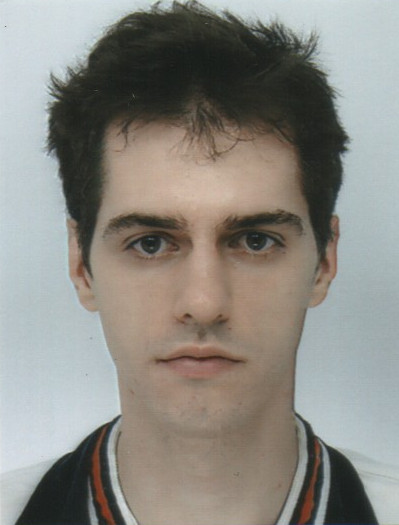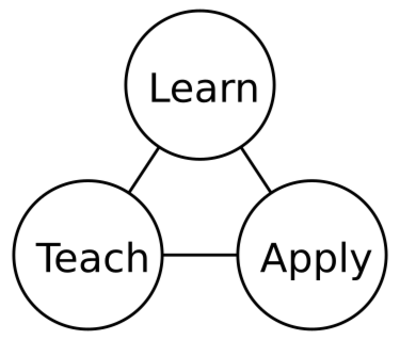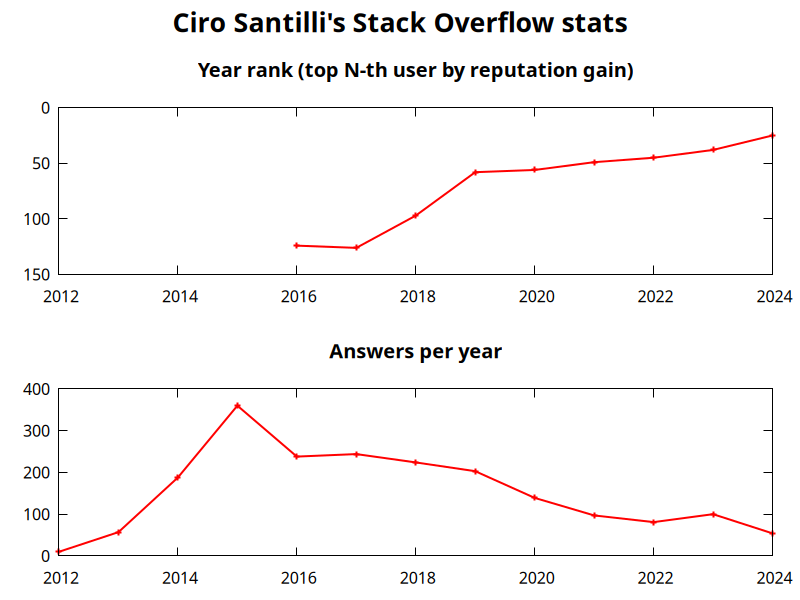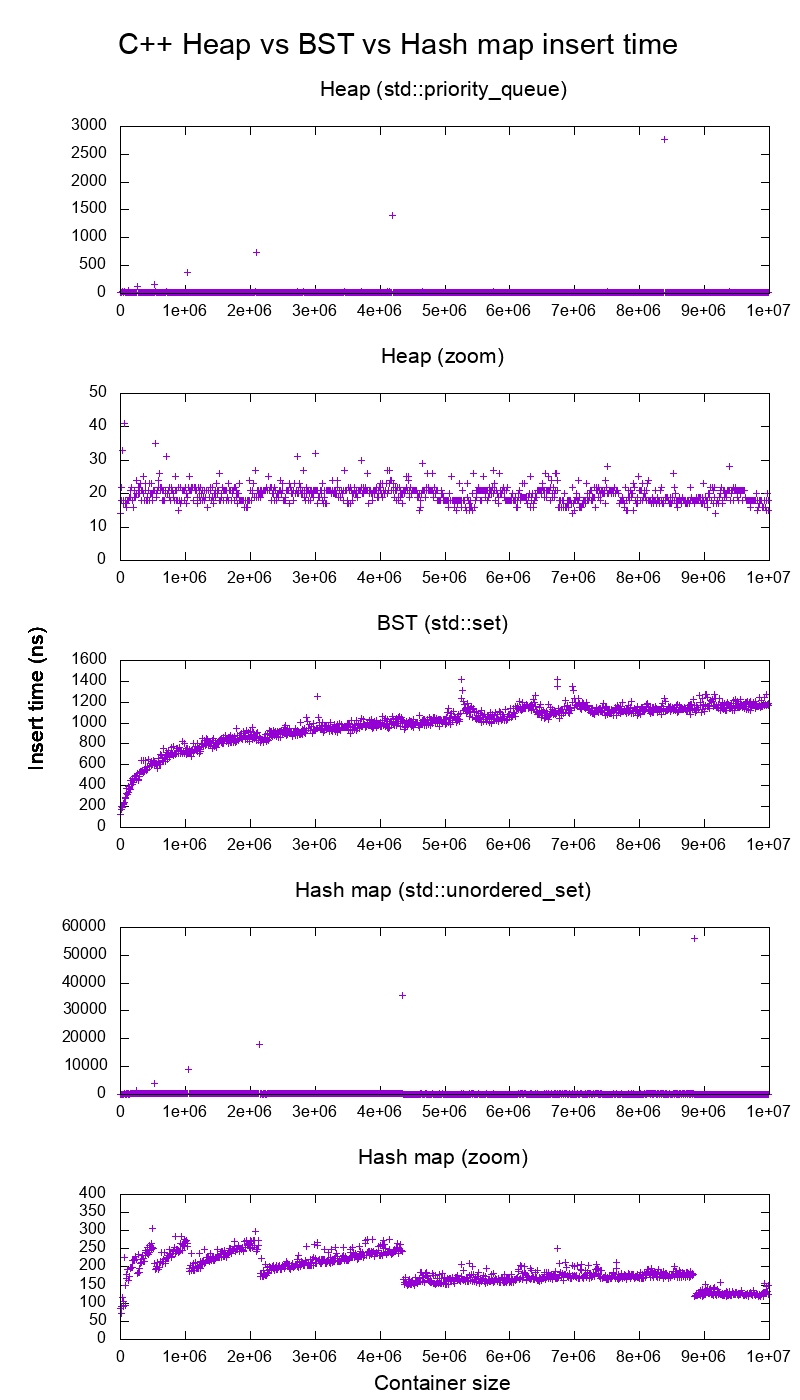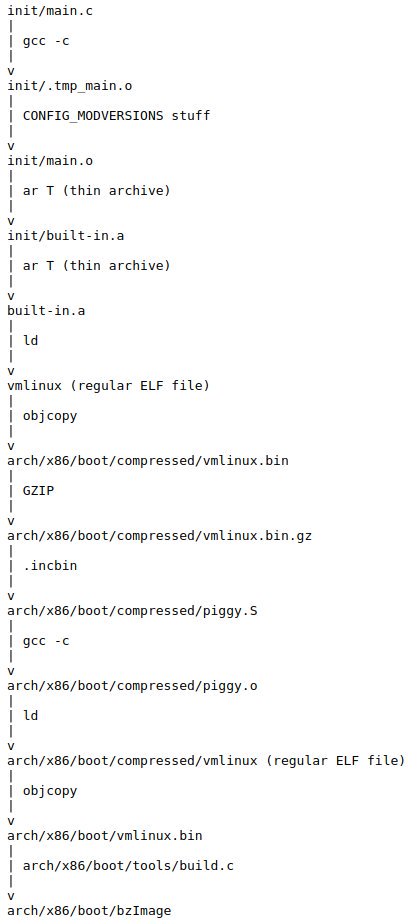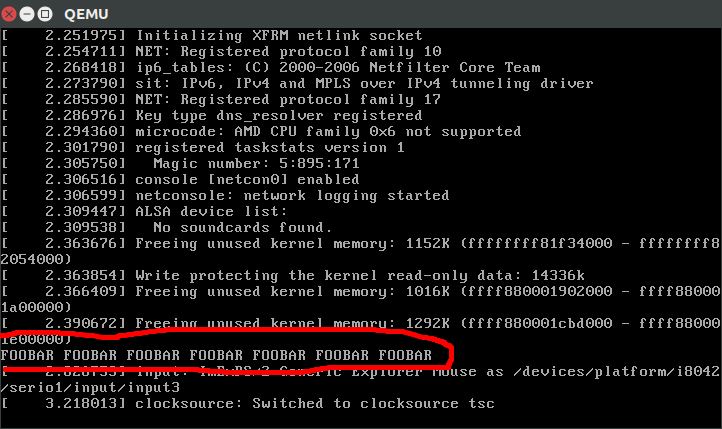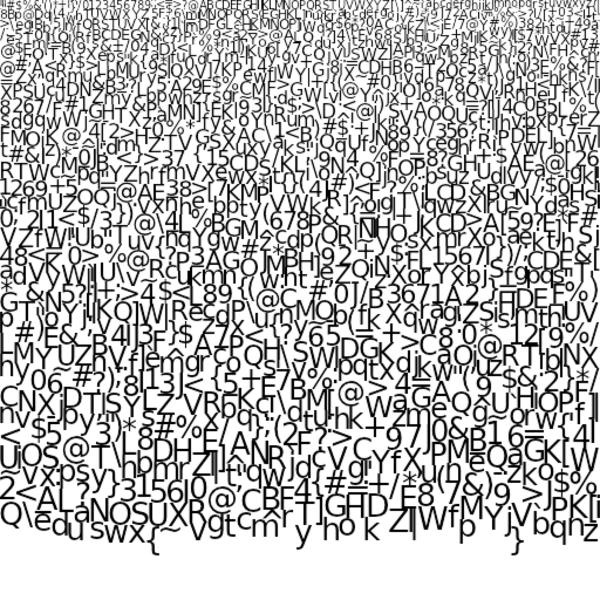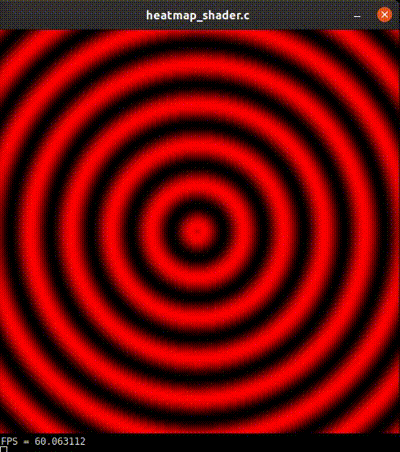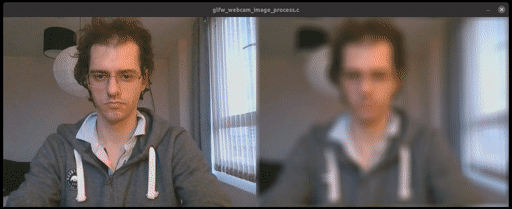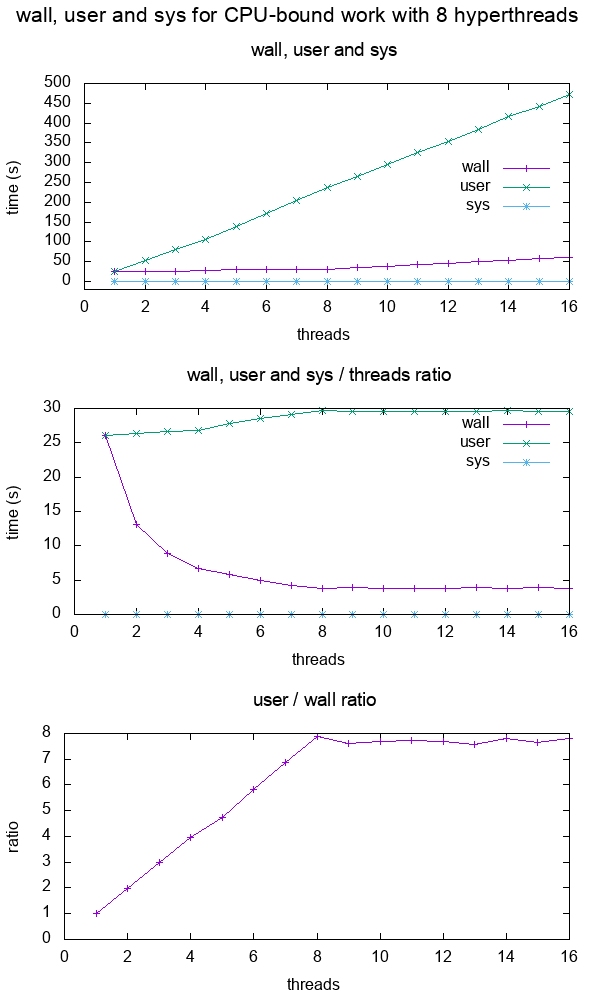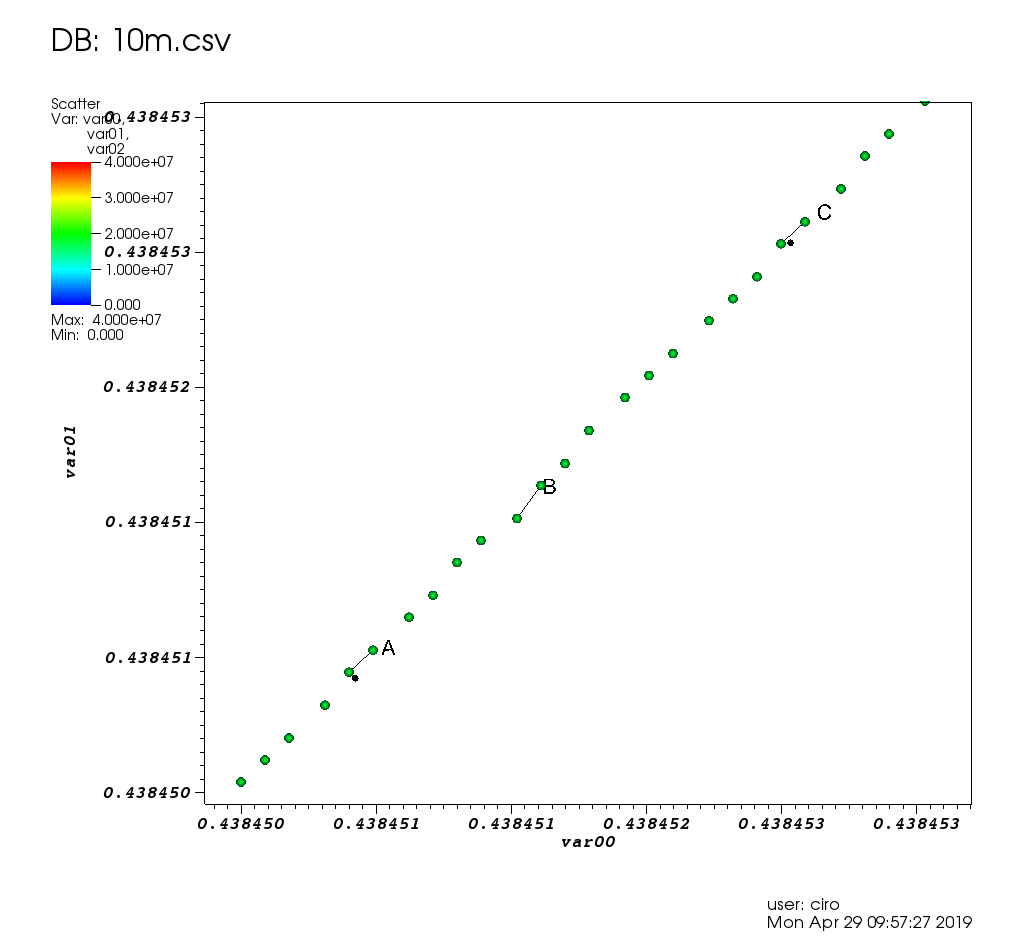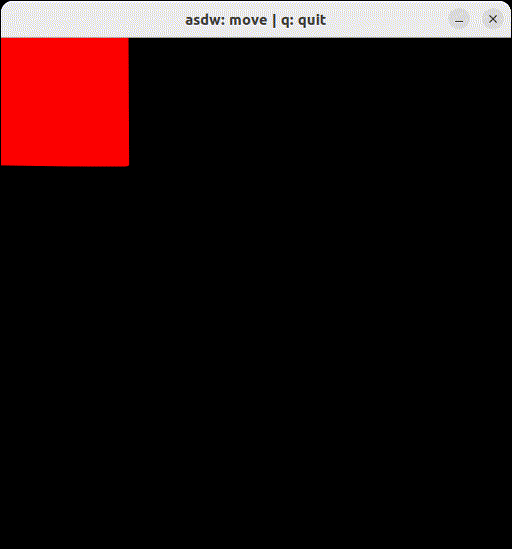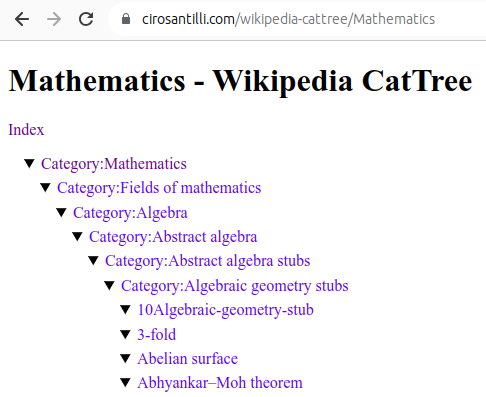Home Updated 2025-12-02
Check out: OurBigBook.com, the best way to publish your scientific knowledge. It's an open source note taking system that can publish from lightweight markup files in your computer both to a multi-user mind melding dynamic website, or as a static website. It's like Wikipedia + GitHub + Stack Overflow + Obsidian mashed up. Source code: github.com/ourbigbook/ourbigbook.
Sponsor me to work on this project. For 400k USD I will quit my job or not get a new job and work on OurBigBook full time for a second year to try and kickstart The Higher Education Revolution. Status: ~44k / 400k USD. At 4M USD I retire/tenure and work on open STEM forever. How to donate: Section "Sponsor Ciro Santilli's work on OurBigBook.com".
I first quit my job 1st June 2024 to work on the project for 1 year after I reached my initial 100k goal mostly via a 1000 Monero donation. For a second follow up year, I increased my requirement to 400k USD to give me more peace of mind as I'm destroying my career in the process. A second year greatly improve chances of success: on year one I improved my tech, on year two I want to come guns blazing to solve courses and get users.
Mission: to live in a world where you can learn university-level mathematics, physics, chemistry, biology and engineering from perfect free open source books that anyone can write to get famous. More rationale: Section "OurBigBook.com"
Explaining things is my superpower, e.g. I was top user #39 on Stack Overflow in 2023[ref][ref] and I have a few 1k+ star educational GitHub repositories[ref][ref][ref][ref]. Now I want to bring that level of awesomeness to masters level Mathematics and Physics. But I can't do it alone! So I created OurBigBook.com to allow everyone to work together towards the perfect book of everything.
My life's goal is to bring hardcore university-level STEM open educational content to all ages. Sponsor me at github.com/sponsors/cirosantilli starting from 1$/month so I can work full time on it. Further information: Section "Sponsor Ciro Santilli's work on OurBigBook.com". Achieving what I call "free gifted education" is my Nirvana.
This website is written in OurBigBook Markup, and it is published on both cirosantilli.com (static website) and outbigbook.om/cirosantilli (multi-user OurBigBook Web instance). Its source code is located at: github.com/cirosantilli/cirosantilli.github.io and also at
cirosantilli.com/_dir and it is licensed under CC BY-SA 4.0 unless otherwise noted.To contact Ciro, see: Section "How to contact Ciro Santilli". He likes to talk with random people of the Internet.
GitHub | Stack Overflow | LinkedIn | YouTube | Twitter | Wikipedia | Zhihu 知乎 | Weibo 微博 | Other accounts
Besides that, I'm also a freedom of speech slacktivist and recreational cyclist. I like Chinese traditional music and classic Brazilian pop. Opinions are my own, but they could be yours too. Tax the rich.
Let's create an educational system with:
- no distinction between university and high school, students just go as fast as they can to what they really want without stupid university entry exams
- fully open source learning material
- on-demand examinations that anyone can easily take without prerequisites
- granular entry selection only for space in specific laboratories or participation in specific novel research projects
I offer:
- online private tutoring for:
- any STEM university course
- passionate younger STEM students (any age) who want to learn university level material and beyond. Can your kid be the next Fields Medalist or Nobel Prize winner? I'm here to help, especially if you are filthy rich! I focus moving students forward as fast as they want on and on producing useful novel tutorials and results
Let your child be my Emile, and me be their Adolfo Amidei, and let's see how far they can go! I will help take your child:and achieve their ambitious STEM goals!- into the best universities
- into the best PhD programs
- educational consulting for institutions looking to improve their STEM courses
- do you know that course or teacher that consistently gets bad reviews every year? I'll work with the teacher to turn the problem around!
- are you looking to create a consistent open educational resources offering to increase your institutions internationally visibility? I can help with that too.
My approach is to:For minors, parents are welcome to join video calls, and all interactions with the student will be recorded and made available to parents.
- propose interesting research projects. The starting point is always deciding the end goal: Section "Backward design"
- learn what is needed to do the project together with the student(s)
- publish any novel results or tutorials/tools produced freely licensed online, and encourage the student to do the same (Section "Let students learn by teaching", digital garden)
I have a proven track of explaining complex concepts in an interesting and useful way. I work for the learner. Teaching statement at: Section "How to teach". Pricing to be discussed. Contact details at: Section "How to contact Ciro Santilli".
I am particularly excited about pointing people to the potential next big things, my top picks these days are:I am also generally interested in:
- quantum computing
- AGI research, in particular AI code generation, automated theorem proving and robotics
- assorted molecular biology technologies
- 20th century physics, notably AMO and condensed matter
- the history of science, and in particular trying to look at seminal papers of a field
Ciro Santilli's amazing Stack Overflow profile
. Ciro contributes almost exclusively by answering question he Googles into out of his own need, and never by refreshing the newest question of big tags for low hanging fruit! More information at: Section "Ciro Santilli's Stack Overflow contributions".Ciro Santilli's Stack Overflow stats
. Further methodology details at: Figure "Ciro Santilli's Stack Overflow stats".The problem with education by Ciro Santilli
. Source. In this video Ciro Santilli exposes his fundamental philosophy regarding why Education is broken. This philosophy was the key motivation behind the failed OurBigBook Project.OurBigBook Web topics demo
. Source. The OurBigBook topic feature allows users to "merge their minds" in a "sort by upvote"-stack overflow-like manner for each subject. This is the killer feature of OurBigBook Web. More information at: docs.ourbigbook.com/ourbigbook-web-topics.OurBigBook dynamic article tree demo
. Source. The OurBigBook dynamic tree feature allows any of your headers to be the toplevel h1 header of a page, while still displaying its descendants. SEO loves this, and it also allows users to always get their content on the correct granularity. More information at: docs.ourbigbook.com/ourbigbook-web-dynamic-article-tree.OurBigBook local editing and publishing demo
. Source. With OurBigBook you can store your content as plaintext files in a Lightweight markup, and then publish that to either OurBigBook.com to get awesome multi-user features, or as a static website where you are in full control. More information at: docs.ourbigbook.com/publish-your-content.Top Down 2D continuous game with Urho3D C++ SDL and Box2D for Reinforcement learning by Ciro Santilli (2018)
Source. More information: Section "Ciro's 2D reinforcement learning games". This is Ciro's underwhelming stab at the fundamental question: Can AGI be trained in simulations?. This project could be taken much further.Water Margin tribute to Chinese dissidents by Ciro Santilli (2022)
Source. Part of Ciro Santilli's campaign for freedom of speech in China, see also: cirosantilli.com/china-dictatorship/water-margin.Lenovo ThinkPad T430 running a BIOS hello world
. This uses Ciro Santilli's project x86 bare metal examples with source code at: github.com/cirosantilli/x86-bare-metal-examplesLinux Kernel Module Cheat presentation
. Source. This project, with source code at: github.com/cirosantilli/linux-kernel-module-cheat, aims to be the perfect emulation setup to study and develop the Linux kernel, kernel modules, QEMU, gem5 as well as x86_64, ARM userland and baremetal assembly and more.My Bitcoin inscription museum by Ciro Santilli
. Source. Introductory video to Section "Cool data embedded in the Bitcoin blockchain". -------------------------------------
| Force of Will 3 U U |
| --------------------------------- |
| | //////////// | |
| | ////() ()\////\ | |
| | ///_\ (--) \///\ | |
| | ) //// \_____///\\ | |
| | ) \ / / / / | |
| | ) / \ | | / _/ | |
| | ) \ ( ( / / / / \ | |
| | / ) ( ) / ( )/( ) \ | |
| | \(_)/(_)/ /UUUU \ \\\/ | | |
| .---------------------------------. |
| Interrupt |
| ,---------------------------------, |
| | You may pay 1 life and remove a | |
| | blue card in your hand from the | |
| | game instead of paying Force of | |
| | Will's casting cost. Effects | |
| | that prevent or redirect damage | |
| | cannot be used to counter this | |
| | loss of life. | |
| | Counter target spell. | |
| `---------------------------------` |
| l
| Illus. Terese Nelsen |
-------------------------------------Code 1.
ASCII art of a Force of Will Magic: The Gathering card inscribed in the Bitcoin blockchain
. Artist unknown, uploaded December 2014. Part of Section "Cool data embedded in the Bitcoin blockchain" where Ciro Santilli maintains a curated list of such interesting inscriptions.
This was a small project done by Ciro for artistic purposes that received some attention due to the incredible hype surrounding cryptocurrencies at the time. Ciro Santilli's views on cryptocurrencies are summarized at: Section "Are cryptocurrencies useful?".
YellowRobot.jpgJPG image fully embedded in the Bitcoin blockchain depicting some kind of cut material art depicting a yellow robot, inscribed on January 29, 2017.
Ciro Santilli found this image and others during his research for Section "Cool data embedded in the Bitcoin blockchain" by searching for image fingerprints on every transaction payload of the blockchain with a script.
The image was uploaded by EMBII, co-creator of the AtomSea & EMBII upload mechanism, which was responsible for a large part of the image inscriptions in the Bitcoin blockchain.
The associated message reads:This is one of Ciro Santilli's favorite AtomSea & EMBII uploads, as it perfectly encapsules the "medium as an art form" approach to blockchain art, where even non-novel works can be recontextualized into something interesting, here depicting an opposition between the ephemeral and the immutable.
Chiharu [EMBII's Japanese wife] and I found this little yellow robot while exploring Chicago. It will be covered by tar or eventually removed but this tribute will remain. N 41.880778 E -87.629210
2010 Wayback Machine archive of starwarsweb.net
. This website was used as one of the CIA 2010 covert communication websites, a covert system the CIA used to communicate with its assets. More details at: Section "CIA 2010 covert communication websites".
Ciro Santilli had some naughty OSINT fun finding some of the websites of this defunct network in 2023 after he heard about the 2022 Reuters report on the matter, which for the first time gave away 7 concrete websites out of a claimed 885 total found. As of November 2023, Ciro had found about 350 of them.
2010 Wayback Machine archive of noticiasmusica.net
. This is another website that was used as one of the CIA 2010 covert communication websites. This website is written in Brazilian Portuguese, and therefore suggests that the CIA had assets in Brazil at the time, and thus was spying on a "fellow democracy".
Although Snowden's revelations made it extremely obvious to the world that the USA spies upon everyone outside of the Five Eyes, including fellow democracies, it is rare to have such a direct a concrete proof of it visible live right on the Wayback Machine. Other targeted democracies include France, Germany, Italy and Spain. More details at: USA spying on its own allies.
This investigative report by Ciro Santilli was featured on the Daily Mail after 404 Media reported on it in 2025.
Diagram of the fundamental theorem on homomorphisms by Ciro Santilli (2020)
Shows the relationship between group homomorphisms and normal subgroups.
Used in the Stack Exchange answer to What is the intuition behind normal subgroups? One of Section "The best articles by Ciro Santilli".
Spacetime diagram illustrating how faster-than-light travel implies time travel by Ciro Santilli (2021)
Used in the Stack Exchange answer to Does faster than light travel imply travelling back in time?. One of Section "The best articles by Ciro Santilli".Average insertion time into heaps, binary search tree and hash maps of the C++ standard library by Ciro Santilli (2015)
Source. Used in the Stack Overflow answer to Heap vs Binary Search Tree (BST). One of Section "The best articles by Ciro Santilli".Birch and Swinnerton-Dyer conjecture in two minutes by Ciro Santilli
. Source. Quick and direct explanation of the statement of the BSD conjecture for people who know basic university mathematics. This is one of the Millennium Prize Problems, and you will get a million dollars if you can solve it! This therefore falls in the Simple to state but hard to prove of Ciro Santilli's the beauty of mathematics aesthetics.Top view of an open Oxford Nanopore MinION
. Source. This is Ciro Santilli's hand on the Wikipedia article: en.wikipedia.org/wiki/Oxford_Nanopore_Technologies. He put it there after working a bit on Section "How to use an Oxford Nanopore MinION to extract DNA from river water and determine which bacteria live in it" :-) And he would love to document more experiments like that one Section "Videos of all key physics experiments", but opportunities are extremely rare.A quick 2D continuous AI game prototype for reinforcement learning written in Matter.js, you can view it on a separate page at cirosantilli.com/_raw/js/matterjs/examples.html#top-down-asdw-fixed-viewport. This is a for-fun-only prototype for Ciro's 2D reinforcement learning games, C++ or maybe Python (for the deep learning ecosystem) seems inevitable for a serious version of such a project. But it is cute how much you can do with a few lines of Matter.js!
HTML snippet:
<iframe src="_raw/js/matterjs/examples.html#top-down-asdw-fixed-viewport" width="1000" height="850"></iframe> Andy Matuschak Updated 2025-07-16
Proponent of evergreen notes.
He's also curious about quantum computing: quantum.country/ like Ciro Santilli. Some crazy overlaps we get.
Applications of Josephson Junctions Updated 2025-07-16
- the basis for the most promising 2019 quantum computing implementation: superconducting quantum computer
- Josephson voltage standard: the most practical/precise Volt standard, which motivated the definition of the ampere in the 2019 redefinition of the SI base units
- SQUID devices, which are:
- very precise magnetometer
- the basis for superconducting quantum computers
The best articles by Ciro Santilli Updated 2025-07-16
These are the best articles ever authored by Ciro Santilli, most of them in the format of Stack Overflow answers.
Ciro posts update about new articles on his Twitter accounts.
Some random generally less technical in-tree essays will be present at: Section "Essays by Ciro Santilli".
- Trended on Hacker News:
- CIA 2010 covert communication websites on 2023-06-11. 190 points, a mild success.
- x86 Bare Metal Examples on 2019-03-19. 513 points. The third time something related to that repo trends. Hacker news people really like that repo!
- again 2020-06-27 (archive). 200 points, repository traffic jumped from 25 daily unique visitors to 4.6k unique visitors on the day
- How to run a program without an operating system? on 2018-11-26 (archive). 394 points. Covers x86 and ARM
- ELF Hello World Tutorial on 2017-05-17 (archive). 334 points.
- x86 Paging Tutorial on 2017-03-02. Number 1 Google search result for "x86 Paging" in 2017-08. 142 points.
- x86 assembly
- What does "multicore" assembly language look like?
- What is the function of the push / pop instructions used on registers in x86 assembly? Going down to memory spills, register allocation and graph coloring.
- Linux kernel
- What do the flags in /proc/cpuinfo mean?
- How does kernel get an executable binary file running under linux?
- How to debug the Linux kernel with GDB and QEMU?
- Can the sys_execve() system call in the Linux kernel receive both absolute or relative paths?
- What is the difference between the kernel space and the user space?
- Is there any API for determining the physical address from virtual address in Linux?
- Why do people write the
#!/usr/bin/envpython shebang on the first line of a Python script? - How to solve "Kernel Panic - not syncing: VFS: Unable to mount root fs on unknown-block(0,0)"?
- Single program Linux distro
- QEMU
- gcc and Binutils:
- How do linkers and address relocation works?
- What is incremental linking or partial linking?
- GOLD (
-fuse-ld=gold) linker vs the traditional GNU ld and LLVM ldd - What is the -fPIE option for position-independent executables in GCC and ld? Concrete examples by running program through GDB twice, and an assembly hello world with absolute vs PC relative load.
- How many GCC optimization levels are there?
- Why does GCC create a shared object instead of an executable binary according to file?
- C/C++: almost all of those fall into "disassemble all the things" category. Ciro also does "standards dissection" and "a new version of the standard is out" answers, but those are boring:
- What does "static" mean in a C program?
- In C++ source, what is the effect of
extern "C"? - Char array vs Char Pointer in C
- How to compile glibc from source and use it?
- When should
static_cast,dynamic_cast,const_castandreinterpret_castbe used? - What exactly is
std::atomicin C++?. This answer was originally more appropriately entitled "Let's disassemble some stuff", and got three downvotes, so Ciro changed it to a more professional title, and it started getting upvotes. People judge books by their covers. notmain.o 0000000000000000 0000000000000017 W MyTemplate<int>::f(int) main.o 0000000000000000 0000000000000017 W MyTemplate<int>::f(int)Code 1.. From: What is explicit template instantiation in C++ and when to use it?nmoutputs showing that objects are redefined multiple times across files if you don't use template instantiation properly
- IEEE 754
- What is difference between quiet NaN and signaling NaN?
- In Java, what does NaN mean?
Without subnormals: +---+---+-------+---------------+-------------------------------+ exponent | ? | 0 | 1 | 2 | 3 | +---+---+-------+---------------+-------------------------------+ | | | | | | v v v v v v ----------------------------------------------------------------- floats * **** * * * * * * * * * * * * ----------------------------------------------------------------- ^ ^ ^ ^ ^ ^ | | | | | | 0 | 2^-126 2^-125 2^-124 2^-123 | 2^-127 With subnormals: +-------+-------+---------------+-------------------------------+ exponent | 0 | 1 | 2 | 3 | +-------+-------+---------------+-------------------------------+ | | | | | v v v v v ----------------------------------------------------------------- floats * * * * * * * * * * * * * * * * * ----------------------------------------------------------------- ^ ^ ^ ^ ^ ^ | | | | | | 0 | 2^-126 2^-125 2^-124 2^-123 | 2^-127Code 2.Visualization of subnormal floating point numbers vs what IEEE 754 would look like without them. From: What is a subnormal floating point number?
- Computer science
- Algorithms
Figure 5. Average insertion time into heaps, binary search tree and hash maps of the C++ standard library. Source. From: Heap vs Binary Search Tree (BST)
- Is it necessary for NP problems to be decision problems?
- Polynomial time and exponential time. Answered focusing on the definition of "exponential time".
- What is the smallest Turing machine where it is unknown if it halts or not?. Answer focusing on "blank tape" initial condition only. Large parts of it are summarizing the Busy Beaver Challenge, but some additions were made.
- Algorithms
- Git
| 0 | 4 | 8 | C | |-------------|--------------|-------------|----------------| 0 | DIRC | Version | File count | ctime ...| 0 | ... | mtime | device | 2 | inode | mode | UID | GID | 2 | File size | Entry SHA-1 ...| 4 | ... | Flags | Index SHA-1 ...| 4 | ... |Code 3.ASCII art depicting the binary file format of the Git index file. From: What does the git index contain EXACTLY?tree {tree_sha} {parents} author {author_name} <{author_email}> {author_date_seconds} {author_date_timezone} committer {committer_name} <{committer_email}> {committer_date_seconds} {committer_date_timezone} {commit message}Code 4.Description of the Git commit object binary data structure. From: What is the file format of a git commit object data structure?- How do I clone a subdirectory only of a Git repository?
- Python
- Web technology
- OpenGL
Figure 7. OpenGL rendering output dumped to a GIF file. Source. From: How to use GLUT/OpenGL to render to a file?- What are shaders in OpenGL?
- Why do we use 4x4 matrices to transform things in 3D?
Figure 10. Sinusoidal circular wave heatmap generated with an OpenGL shader at 60 FPS on SDL. Source.
- Node.js
- Ruby on Rails
- POSIX
- What is POSIX? Huge classified overview of the most important things that POSIX specifies.
- Systems programming
- What do the terms "CPU bound" and "I/O bound" mean?
Figure 12. Plot of "real", "user" and "sys" mean times of the output of time for CPU-bound workload with 8 threads. Source. From: What do 'real', 'user' and 'sys' mean in the output of time?+--------+ +------------+ +------+ | device |>---------------->| function 0 |>----->| BAR0 | | | | | +------+ | |>------------+ | | | | | | | +------+ ... ... | | |>----->| BAR1 | | | | | | +------+ | |>--------+ | | | +--------+ | | ... ... ... | | | | | | | | +------+ | | | |>----->| BAR5 | | | +------------+ +------+ | | | | | | +------------+ +------+ | +--->| function 1 |>----->| BAR0 | | | | +------+ | | | | | | +------+ | | |>----->| BAR1 | | | | +------+ | | | | ... ... ... | | | | | | +------+ | | |>----->| BAR5 | | +------------+ +------+ | | | ... | | | +------------+ +------+ +------->| function 7 |>----->| BAR0 | | | +------+ | | | | +------+ | |>----->| BAR1 | | | +------+ | | ... ... ... | | | | +------+ | |>----->| BAR5 | +------------+ +------+Code 5.Logical struture PCIe device, functions and BARs. From: What is the Base Address Register (BAR) in PCIe?
- Electronics
- Raspberry Pi
Figure 13. Raspberry Pi 2 directly connected to a laptop with an Ethernet cable. Image from answer to: How to hook up a Raspberry Pi via Ethernet to a laptop without a router?Figure 14. . Image from answer to: How to hook up a Raspberry Pi via Ethernet to a laptop without a router? Figure 15. . Image from answer to: How to emulate the Raspberry Pi 2 on QEMU? Figure 16. Bare metal LED blinker program running on a Raspberry Pi 2. Image from answer to: How to run a C program with no OS on the Raspberry Pi?
- Raspberry Pi
- Computer security
- Media
Video 2. Canon in D in C. Source.The original question was deleted, lol...: How to programmatically synthesize music?- How to resize a picture using ffmpeg's sws_scale()?
- Is there any decent speech recognition software for Linux? ran a few examples manually on
vosk-apiand compared to ground truth.
- Eclipse
- Computer hardware
- Scientific visualization software
Figure 17. VisIt zoom in 10 million straight line plot with some manually marked points. Source. From: Section "Survey of open source interactive plotting software with a 10 million point scatter plot benchmark by Ciro Santilli"
- Numerical analysis
- Computational physics
- Register transfer level languages like Verilog and VHDL
- Verilog:
Figure 19. . See also: Section "Verilator interactive example"
- Verilog:
- Android
Video 4. Android screen showing live on an Ubuntu laptop through ADB. Source. From: How to see the Android screen live on an Ubuntu desktop through ADB?
- Debugging
- Program optimization
- What is tail call optimization?
Figure 21. . Source. The answer compares gprof, valgrind callgrind, perf and gperftools on a single simple executable.
- Data
Figure 22. Mathematics dump of Wikipedia CatTree. Source. In this project, Ciro Santilli explored extracting the category and article tree out of the Wikipedia dumps.
- Mathematics
Figure 23. Diagram of the fundamental theorem on homomorphisms by Ciro Santilli (2020)Shows the relationship between group homomorphisms and normal subgroups.- Section "Formalization of mathematics": some early thoughts that could be expanded. Ciro almost had a stroke when he understood this stuff in his teens.
Figure 24. Simple example of the Discrete Fourier transform. Source. That was missing from Wikipedia page: en.wikipedia.org/wiki/Discrete_Fourier_transform!
- Network programming
- Physics
- What is the difference between plutonium and uranium?
Figure 25. Spacetime diagram illustrating how faster-than-light travel implies time travel. From: Does faster than light travel imply travelling back in time?
- Biology
Figure 26. Top view of an open Oxford Nanopore MinION. Source. From: Section "How to use an Oxford Nanopore MinION to extract DNA from river water and determine which bacteria live in it"Figure 27. Mass fractions in a minimal growth medium vs an amino acid cut in a simulation of the E. Coli Whole Cell Model by Covert Lab. Source. From: Section "E. Coli Whole Cell Model by Covert Lab"
- Quantum computing
- Section "Quantum computing is just matrix multiplication"
Figure 28. Visualization of the continuous deformation of states as we walk around the Bloch sphere represented as photon polarization arrows. From: Understanding the Bloch sphere.
- Bitcoin
- GIMP
Figure 29. GIMP screenshot part of how to combine two images side-by-side in GIMP?
- Home DIY
Figure 30. Total_Blackout_Cassette_Roller_Blind_With_Curtains.Source. From: Section "How to blackout your window without drilling"
- China
BQP Updated 2025-07-16
P for quantum computing!
Heck, we know nothing about this class yet related to non quantum classes!
- conjectured not to intersect with NP-complete, because if it were, all NP-complete problems could be solved efficiently on quantum computers, and none has been found so far as of 2020.
- conjectured to be larger than P, but we don't have a single algorithm provenly there:
- it is believed that the NP complete ones can't be solved
- if they were neither NP-complete nor P, it would imply P != NP
- we just don't know if it is even contained inside NP!
Chemistry Updated 2025-07-16
Chemistry is fun. Too hard for precise physics (pre quantum computing, see also quantum chemistry), but not too hard for some maths like social sciences.
And it underpins biology.
Classical computer Updated 2025-07-16
ColdQuanta Updated 2025-07-16
Not a quantum computing pure-play, they also do sensing.
Continuous-variable quantum information Updated 2025-07-16
It is also possible to carry out quantum computing without qubits using processes with a continuous spectrum of measurement.
As of 2020, these approaches seem less developed/promising, but who knows.
Deep tech Updated 2025-07-16
It basically came about because of the endless stream of useless software startups made since the 2000's by one or two people with no investments with the continued increase in computers and Internet speeds until the great wall was reached.
Deep tech means not one of those. More specifically, it means technologies that require significant investment in expensive materials and laboratory equipment to progress, such as molecular biology technologies and quantum computing.
And it basically comes down to technologies that wrestle with the fundamental laws of physics rather than software data wrangling.
Computers are of course limited by the laws of physics, but those are much hidden by several layers of indirection.
Full visibility, and full control, make computer tasks be tasks that eventually always work out more or less as expected.
The same does not hold true when real Physics is involved.
Physics is brutal.
To start with, you can't even see your system very clearly, and often doing so requires altering its behaviour.
For example, in molecular biology, most great discoveries are made after some new technique is made to be able to observe smaller things.
But you often have to kill your cells to make those observations, which makes it very hard to understand how they work dynamically.
What we would really want would be to track every single protein as it goes about inside the cell. But that is likely an impossible dream.
The same for the brain. If we had observations of every neuron, how long would it take to understand it? Not long, people are really good at reverse engineering things when there is enough information available to do so, see also science is the reverse engineering of nature.
Then, even when you start to see the system, you might have a very hard time controlling it, because it is so fragile. This is basically the case of quantum computing in 2020.
The next big things will come from deep tech. Failure is always a possibility, and you can't know before you try.
But that's also why its so fun to dare.
Stuff that Ciro Santilli considers "deep tech" as of 2020:
- brain-computer interface
- fusion power. The question there is, when is "deep", "too deep"?
Fusion power Updated 2025-07-16
Most promising approaches as of 2020:
Why Private Billions Are Flowing Into Fusion by Bloomberg (2022)
Source. - Joint European Torus
- General Fusion: compress with liquid metal. Intends to demo in JET site.
- Helion Energy: direct fusion to electricity conversion without steam, direct from magnetic field movements
- First Light: shootjobs.lever.co/proximafusion/23aab9a8-34ec-40d2-bb14-440f1130021c microscopic objct at a target to crush it so much that fusion happens
Introduction to quantum computing Updated 2025-08-08
Course plan:
- Section "Programmer's model of quantum computers"
- look at a Qiskit hello world
- e.g. ours: qiskit/hello.py
- learn about quantum circuits.
- tensor product in quantum computing
- First we learn some quantum logic gates. This shows an alternative, and extremely important view of a quantum computer besides a matrix multiplication: as a circuit. Fundamental subsections:
- quantum algorithms
Job application by Ciro Santilli Created 2025-04-18 Updated 2025-11-05
2025 round one during week of April 21st, not toning down online profiles:Keywords:
- quantum computing:
- Paris quantum computing:
- Alice&Bob:
- jobs.lever.co/alice-bob/2acf8f0c-6947-41ad-b30f-9779a1b49681 Senior Software Engineer, Framework team
I'm looking to do a meaningful job in a deeptech field, and quantum computing seems like it could become huge. I've learnt a few basics, and would like to go further with job experience in the area.
Salary: 90k.Rejected after first interview with the hiring manager. They said they wanted someone with more experience setting up CI/CD. - 2025-07-03 jobs.lever.co/alice-bob/b4632e27-cf56-4570-84bb-d56a169d1c43 Senior Software Engineer - Cloud. Webdev. I don't really want to do this, but it's a way in. Asking salary: 70k. Rejected 2025-07-11.
- 2025-09-02 jobs.lever.co/alice-bob/b7386caa-70dd-4670-bb69-a5c97322332f Senior Software Engineer - Firmware Calibration
- Pasqal:
- careers.pasqal.com/jobs/5817098-software-development-engineer-integration Software Development Engineer IntegrationApplication auto-reply also points to:which is cool.I'm looking to do a meaningful job in a deeptech field, and quantum computing seems like it could become huge. I've learnt a few basics, and would like to go further with job experience in the area.Rejected 1 week later without interview even though my CV seemed like a perfect match for this job. Sent an email to the contributors of Pulser.After the application they keep sending you relevant new job openings, which was really good, applying to another one:I applied for this job careers.pasqal.com/jobs/5817098-software-development-engineer-integration but got rejected by HR lady without interview.Pinging you guys here just in case because sometimes my profiles scare the HR people and then when I ping the programmers they like me. I grabbed your emails from GitHub.
- 2025-06-20 careers.pasqal.com/jobs/6075845-embedded-software-engineer-w-m Embedded Software engineerRejected 2025-07-03.Why Pasqal?I want to get into quantum computing in France, and there are only 5 major hardware companies and I'm applying to each of them when there's a job that seems that I can do. I don't know enough to pick the one with the tech that is most promising to win, though it seems no one can at this point. Being in Massy, a little further from central Paris, is a plus, I like quieter areas.
- 2025-09-04 careers.pasqal.com/fr/jobs/6379846-mid-senior-software-engineer-h-f Mid-Senior Software Engineer - H/F. Cloud.Rejected 2025-09-26.
J'ai une forte envie de faire ce job. Le quantum computing a l'air trop cool, l'impact pourrait être énorme, et les techs de base (high performance computing) du job m'amusent aussi. Mes études basiques jusqu'à présent : cirosantilli.com/quantum-computing. Ma femme est employée par une entreprise française et je cherche à déménager dans la région parisienne.
- C12 Quantum Electronics
- 2025-06-20 Senior Measurement Software Engineer jobs.lever.co/c12qe/0b27ff8c-a094-4da4-ba32-2ecd55ae6233
I am interested in getting into quantum computing because the this field seems like it could be promising. My wife is French and working for a French company in Paris and we are looking to relocate to the greater Paris region. I've heard good things from the company. I have only done basic undergrad physics in university but I'm very interested in learning more from a more concrete point of view, AMO seems really cool. I can handle low level programming well.
- jobs.lever.co/c12qe/82658084-331d-4ba3-bc01-cec1d364cfe4 Junior Software Engineer. Rejected 2025-09-22.
- Quandela:
- 2025-09-05 apply.workable.com/quandela/j/546CECA897/ Support QPU Engineer - Technical Account Manager. Was stated as software engineer on LinkedIn I think. Rejected 2025-09-09.
- Welinq: none yet but add to loop
- Alice&Bob:
- UK quantum computing:
- Oxford Ionics
2025-07-15 Senior Software Engineer apply.workable.com/oxford-ionics/j/F82EC50A7A/Rejected 2025-07-29.I would like to work in quantum computing as the field seems promising. The software hw stack also seems really cool, python rust artiq and FPGA, sign me up for that.
- Riverlane
- 2026-08-17
- apply.workable.com/riverlane/j/5B86BF380A/ System Software Engineer. Rejected 2025-08-29.
- apply.workable.com/riverlane/j/42D4AB487A/ Software Engineer - Modelling. Rejected 2025-09-09.
I've been watching quantum computing lightly from a distance, and I would be very excited to get involved and try to help, it seems like something really worth trying for humanity, my notes: cirosantilli.com/quantum-computing I'm very curious about learning more about the physics of quantum computers and error correction.
- Quantinuum
- 2025-08-26 jobs.eu.lever.co/quantinuum/0535d099-4f84-4ef3-a3fa-a182dde4362a Backend Software Engineer. Rejected 2025-08-29.
- Infleqtion
Python is my default scripting language and I've used it in all my enterprise jobs. Eg on open source here is a Linux kernel development setup I've automated with python github.com/cirosantilli/linux-kernel-module-cheat and here is a VCD parser I've adopted github.com/cirosantilli/vcdvcd
- Oxford Ionics
- Other quantum computing:
- Haiqu: www.linkedin.com/jobs/view/4289782247 Software Engineer (Quantum Platform and Tools)
- ParityQC: parityqc.com/careers Software Engineer for Quantum Computing. I did two interviews and was seriously considered for the position I believe. But at that point I had already accepted another offer, partly leading to a huge rent increase, so I asked for 80k GBP and living in the UK and that was too much unfortunately. If I had asked for less, and possibly considered moving back to continental Europe, then it might have worked out. Will this be another one of those things that I regret not having done for the rest of my life? Time will tell.
- Paris quantum computing:
- Machine learning
- UK machine learning
- DeepMind:
- Turned down two days later before anything.As evidenced by my Stack Exchange contributions, I love trying out new software to see if it works and how well. I love benchmarking it. And I love documenting what I observed in great detail to help others to choose the best software for them. I also love meeting various new people and understanding what they are up to and how I can help.
- job-boards.greenhouse.io/deepmind/jobs/6576118 Software Engineer, Hardware Design
At ARM and AMD I've worked on various different parts of the hardware cycle, notably C++ emulation and low level software. I just get this strong feeling that hardware and low level software design should be the easiest thing for machines to automate, as it is the area that requires the least amount of "common sense" information about the world.
- Reflection AI: 2025-10-10 jobs.ashbyhq.com/reflectionai/5fa84d35-6e2c-409c-b2fe-6bc211a94091 Member of Technical Staff - Software Engineer. Rejected 2025-10-12 of course.
- DeepMind:
- Paris machine learning:
- H Company:Fastest initial job application steps ever! Name, email, CV, over.
- jobs.ashbyhq.com/hcompany/e6793ce6-918b-48a6-bf56-205c477cc1c0 Member of technical staff (Evaluations). Declined 12th June.
- jobs.ashbyhq.com/hcompany/89d867e7-2bd3-4918-aebc-cabbac526b6f Senior Back-end Engineer
- Mistral AI:
- jobs.lever.co/mistral/db67d7a2-bcec-4151-9b3a-8212ddabf419 Senior Software Engineer, Data Engineering - Paris. Declined May 7th without interview, at least they said they have lots of applicants and some have more closely related qualifications.
- 2025-07-03
- jobs.lever.co/mistral/c1e1e2c0-03f4-4434-938a-a5df3080baf2 Software Engineer, IDE (Typescript), (Contractor). VS Code browser extension.
Available from September. I made this extension as a small part of my personal project over a month full time: marketplace.visualstudio.com/items?itemName=ourbigbook.ourbigbook-vscode It has no installs because the personal project is a failure, but the extension works. I can do other stuff besides the vscode extension itself as well. But I need at least 1 year contract.
- jobs.lever.co/mistral/e76d2957-2bf6-4d8f-90a2-29bf9a927823 Software Engineer, Product (Python)Got an interview.I have 3 years full time on my failed website: ourbigbook.com/ My frontend is meh but backend is OK. Never done huge volumes though since the project was a failure. But Heroku + my basic PostgreSQL DB fu held up to 3k visits / day when I got some coverage for cirosantilli.com/cia-2010-covert-communication-websites from www.dailymail.co.uk/news/article-14752155/CIA-fake-websites-Star-Wars-communicate-spies.htmlI've also did some automatic population of the database to 100k rows and my indices seem to be right that the website is still usable: docs.ourbigbook.com/news/llm-generated-wikibot-abstracts
- jobs.lever.co/mistral/c1e1e2c0-03f4-4434-938a-a5df3080baf2 Software Engineer, IDE (Typescript), (Contractor). VS Code browser extension.
- Poolside AI:> Of all the applications of deep learning, code generation is one of those that interest me the most as they seem one of the most pertinent in order to one day achieve AGI (the others being theorem proving and robotics), and I'd like to try and get some work experience in the area, which is why I'm applying to your company.
- poolside.ai/careers/member-of-engineering-evaluations--ba11fe78-f6f6-4165-b76b-020a46ad8fee Member of Engineering (Evaluations)
Of all the applications of deep learning, code generation is one of those that interest me the most as they seem one of the most pertinent in order to one day achieve AGI (the others being theorem proving and robotics), and I'd like to try and get some work experience in the area.
- poolside.ai/careers/member-of-engineering-data-platform--13d32f62-d530-4372-b458-0687d99eea04 Member of Engineering (Data Platform)
This job seemed like a possibility as I've done some personal "data intensive" projects in the past (not distributed unfortunately, ~500 GB so it fit on my local disk), and I kind of enjoyed it and would be interested in trying out a more "data heavy" job like this for a change.
Rejected May 6th without interview. - poolside.ai/careers/member-of-engineering-evaluations--ba11fe78-f6f6-4165-b76b-020a46ad8fee Member of Engineering (Evaluations)
- Nabla jobs.ashbyhq.com/nabla/85543350-f2e4-4328-95c2-7716ce143279 Back-End Engineer. There was also a Senior but I didn't have the 5 years experience lol. Rejected 2025-07-21.
- Cohere
- 2026-08-04 jobs.ashbyhq.com/cohere/138b7442-1e5f-439e-97a3-bb9e41673c81 Senior/Staff Software Engineer, EMEA, Agentic Platform. Considered but didn't apply, they asked for too much experience.
- H Company:
- UK machine learning
- Big tech:
- Google. Many jobs in London, nothing in Paris. www.google.com/about/careers/applications/jobs/results
- www.google.com/about/careers/applications/jobs/results/91141790538572486-senior-software-engineer-google-pixel-graphics Senior Software Engineer, Google Pixel Graphics. Went through entire interview process but LeetCode not good enough. Non-Leetcode went great.
- www.google.com/about/careers/applications/jobs/results/96937277808091846-senior-software-engineer-pixel-graphics-gpu-software Senior Software Engineer, Pixel Graphics, GPU Software
- 2025-07-22 www.google.com/about/careers/applications/jobs/results/113249786332619462-senior-software-engineer Senior Software Engineer, TPU Performance, Hardware/Software Co-Design. Hopeless but one must try.
- Amazon, focusing on AWS of course. Lots of jobs in London, nothing in Paris: www.amazon.jobs/en-gb/
- 2025-06-20
- www.amazon.jobs/en/jobs/2915117/software-development-engineer-aws-uk Software Development Engineer, AWS Utility Computing
- www.amazon.jobs/en-gb/jobs/2884321/systems-development-engineer-database-services Systems Development Engineer, Database Services. Rejected two days later on a Sunday, nice.
- www.amazon.jobs/en-gb/jobs/2530616/senior-systems-development-engineer Senior Systems Development Engineer
- www.amazon.jobs/en-gb/jobs/2902679/senior-systems-engineer Senior Systems Engineer
- 2025-06-20
- Apple Inc., focusing on low level and or embedded bullshit just to see if they give interviews:
- jobs.apple.com/en-gb/details/200523081/swe-kernel-engineer-coreos
- jobs.apple.com/en-gb/details/200577840/gpu-driver-engineer-kernel-firmware first received an email saying I would get an interview. But then they 180'ed a few hours later with some excuse. But the job announcement was still up. So it feels like something fishy happened, e.g. I failed some security check.
- jobs.apple.com/en-gb/details/200604360/virtualisation-engineer
- 2025-09-10 jobs.apple.com/en-gb/details/200520511-2114/gpu-modeling-engineer GPU modeling
- Microsoft: a few jobs in London, very few in Paris
- Facebook: several boring jobs in London, a few research jobs in Paris
- Google. Many jobs in London, nothing in Paris. www.google.com/about/careers/applications/jobs/results
- London machine learning:
- InstaDeep:
- www.instadeep.com/job-offer/fea583b3-d333-447e-8811-8ce58367c003/ Software Engineer (Simulation) asking 85k
I really like the idea of using simulations to speed up development of ideas or AI. I've done this in my past jobs in the semiconductor industry, and a bit on side time tinkering with simple simulation games that might be useful to train AI. I'm curious to what you will be simulating! The general areas that your company operates in, biotech and PCB design are also in my interest.lI really like the idea of using simulations to speed up development of ideas or AI. I've done this in my past jobs in the semiconductor industry, and a bit on side time tinkering with simple simulation games that might be useful to train AI. I'm curious to what you will be simulating!
- www.instadeep.com/job-offer/fea583b3-d333-447e-8811-8ce58367c003/ Software Engineer (Simulation) asking 85k
- Anthropic
- 2025-06-18
- job-boards.greenhouse.io/anthropic/jobs/4632138008 Software Engineer, Infrastructure. Declined first thing next Monday.
- job-boards.greenhouse.io/anthropic/jobs/4753256008 Software Engineer, Inference Scalability and Capability. This one suggested JAX, Rust and multi-GPU experience would be good. Haha it's hopeless.
- job-boards.greenhouse.io/anthropic/jobs/4632830008 Software Engineer, ML Performance and Scaling
I just want to help achieve AGI so I don't need to work anymore. I can do non-glamorous things to achieve that goal, but eventually I'd inevitably get into research itself. I haven't done deep learning except basic examples, but I can handle low level stuff, and I want to learn.
Why Anthropic?I'm applying to any LLM companies, and the ones with more funding are more likely to have dumb coding jobs that I can do without a PhD in ML, and more likely to have the resources to reach some critical point if scaling continues. The small labs have the advantage of nimbleness to try new architectures, but they only employ PhDs.I think I got the first stage technical thing for this one. But it was the most weird exercise ever, 2 hours to finish, they had a compiler in Python with a simplified GPU-like architecture and you're supposed to optimize a algorithm written in their custom assembly (writen in plain Python to make things even worse) and I was not able to do anything besides understand the problem somewhat. Then the reject came immediately.In one paragraph, provide an example of something meaningful that you have done in line with your values. Examples could include past work, volunteering, civic engagement, community organizing, donations, family support, etc.*Endless open source knowledge sharing e.g.:- stackoverflow.com/users/895245 Stack Overflow
- github.com/cirosantilli/linux-kernel-module-cheat Linux kernel emulation tutorial
- ourbigbook.com/ my failed knowledge sharing website that only I use
- www.matta.ai/careers/backend-engineer Backend EngineerHi, I'm applying to this job because I get a feeling that using machine learning to improve industry is cool and useful.My backend experience is 3 years full time on my failed open source elearning project: github.com/ourbigbook/ourbigbook / ourbigbook.com/ the last of which I did after receiving a 100k pound grant. The website is written in Node.js + PostgreSQL, but I also like Python (went with Node.js for Next.js in this case) and have used Python professionally on my jobs and also for personal project, see CV or e.g. github.com/cirosantilli/linux-kernel-module-cheat I also did a bit of Django previously.I've never handled huge traffic on that site because it failed to gain interest, but on rare occasions where a post got traction it survived 3k requests / day just fine. I've done some amount of SQL optimization and performance verification, and I've added 100k AI generated posts to it and it survived, meaning my indexes were OK.
- InstaDeep:
- Semiconductor:
- AMD:
* careers.amd.com/careers-home/jobs/57882 Senior Software Development Engineer on ROCm. Rejected a few days later without interview.
* careers.amd.com/careers-home/jobs/65271 Virtual Software Modeling Engineer - Qualcomm: very few client jobs in France, a decent amount in UK, but nothing too good fitting at first glance
- Arm, all with referrals from old colleagues:
- 2025-06-30:
- GPU
- careers.arm.com/job/cambridge/staff-principal-software-engineer/33099/77726588832 Staff Software Engineer - System Performance Analysis GPU driver. Got screening interview. Rejected 2025-07-18.
- careers.arm.com/job/cambridge/staff-software-engineer-system-performance-analysis/33099/77284796288 Staff/Principal Software Engineer. Linux kernel driver. Rejected after final technical interview 2025-08-15.
- careers.arm.com/job/cambridge/principal-software-engineer-machine-learning/33099/82468207936 Principal Software Engineer - Machine Learning. Seems ambitions but friend recommended me so I just clicked. Rejected 2025-07-03.
- careers.arm.com/job/cambridge/staff-gpu-software-applications-engineer/33099/82643339264 Staff GPU software applications engineer. Got screening interview with hiring manager. Got 80k GBP offer 2025-09-04.
- Non-GPU
- carers.arm.com/job/cambridge/staff-software-engineer/33099/74848341808 Staff Software EngineerSounds cool.
This diverse role will largely focus on providing software enablement for our next generation CPU and accelerator based technologies on target use-cases.
- careers.arm.com/job/manchester/staff-application-performance-engineer/33099/80144718528 Staff Application Performance EngineerReally cool. I don't have the perf pre-requisites, but it would be cool to do this. Rejected 2025-07-03.
performance workflows on Arm Neoverse platforms
- careers.arm.com/job/cambridge/senior-software-engineer-machine-learning-tools/33099/74848310720 Senior Software Engineer - Machine Learning Tools. Got screening interview. Rejected 2025-07-16 by hiring manager before interview.
- experienced-arm.icims.com/jobs/14442/senior-linux-kernel-engineer-%e2%80%93-hardware-enablement Senior Linux Kernel Engineer – Hardware Enablement. Rejected 2025-07-05.
- experienced-arm.icims.com/jobs/12987/staff-software-engineer/job?mode=submit_apply Staff Software Engineer
Accelerating algorithms with hand-optimized Arm assembly using the latest Arm technologies such as SVE
- 2025-08-21
- careers.arm.com/job/cambridge/senior-performance-tools-engineer/33099/75816396960 rejected 2025-08-26
- careers.arm.com/job/cambridge/senior-software-performance-analysis-engineer/33099/74720022336 rejected 2025-08-25
- careers.arm.com/job/cambridge/senior-software-engineer-networking-for-ai/33099/81797177488
- careers.arm.com/job/cambridge/senior-software-engineer-cpython-runtime/33099/84058266624 I was not particularly qualified for this but a friend referred so I clicked. Got first technical interview, but rejected because as I told them from the start, I don't know much about interpreters.
- carers.arm.com/job/cambridge/staff-software-engineer/33099/74848341808 Staff Software Engineer
- GPU
- 2025-06-30:
- Intel: no jobs in UK/France
- Nvidia: a few high end jobs in UK/France, some of them are EMEA remote
- 2025-06-30 Senior Software and System Architect nvidia.wd5.myworkdayjobs.com/en-US/NVIDIAExternalCareerSite/job/Spain-Remote/Senior-Software-and-System-Architect_JR1997578?locationHierarchy1=2fcb99c455831013ea52aa2df70e324e Read wrong, seems to require senior networking skills that I don't have, but by then had already asked for a referral from an ex colleague and so just applied anyways. Lol! rejected 2025-07-16
- 2025-06-04 nvidia.wd5.myworkdayjobs.com/NVIDIAExternalCareerSite/job/UK-Remote/Senior-System-Software-Engineer--Base-OS-Kernel_JR1999799 Senior System Software Engineer, Base OS Kernel. Rejected.
- Codasip: no SW jobs in UK, only HW
- SiFive: only 10 jobs globally, 1 sales in UK
- Graphcore:
- 2025-07-02 job-boards.greenhouse.io/graphcore/jobs/7743036002 Staff System Software Engineer. Automation and testing stuff. Got first interview with technical person. Rejected 2025-08-22.
- Undo:
2027-08: client support, through recruiter, did first light technical and went well, did second with manager and not so well then reject. Asked me where I see myself in 5 years and replied no fucking idea whoever pays the most in semiconductors.
- AMD:
- EDA:
- Open source
- Canonical
- Linux kernel engineering: failed after take home exercise
- Common Crawl: commoncrawl.org/jobs Software Engineer/Data Scientist, Python, Spark
- Canonical
- Random compute
- Atos, now mostly Eviden: all jobs require 10 years of experience lol
- Random french tech
- Random deeptech:
- Oxford:
- Oxford Instruments 2025-07-21 jobs.oxinst.com/job/Oxford-Senior-Software-Engineer/819253802/ 70k salary. Cover: I just want to do something sciency. Rejected one day later.
- Proxima Fusion 2025-07-15 Research Software Engineer jobs.lever.co/proximafusion/23aab9a8-34ec-40d2-bb14-440f1130021c Got screening interview, but rejected afterwards on 2025-08-08 before technical.
- Salience Labs 2025-09-10 careers.saliencelabs.ai/jobs/6208031-embedded-software-engineer Rejected 2025-09-20.
- Oxford:
- biotech maybe
- optical compute
- NcodiN: no jobs
- Flux Computing:
- Robotics
- HPC
- Formal proof:
This application is hopeless, but here's the pitch. One thing that would be really really awesome for formal mathematics would be a website where anyone (including bots) can go and prove whatever theorem they want on the web UI or API, and then it gets formally verified, and the proven results shows up on the web UI, and other people can use it for their own further proofs. So it's a bit like Lean's mathlib, but the advantage over a centralized standard library is that you don't need to review people's pull requests. And you can do stuff like "watch if a results is proven". More babling at: ourbigbook.com/cirosantilli/website-front-end-for-a-mathematical-formal-proof-system Cheers.
- self-driving
- GPU
- C++
- Linux
- systems software
- numerical software
- robotics
Julian Kelly Created 2024-12-13 Updated 2025-07-16
Timeline:He went pretty much in a straight line into the quantum computing boom! Well done.
- 2015: joined Google as a Google Quantum AI employee
- 2010: UCSB Physics PhD. His thesis was "Fault-tolerant superconducting qubits" and the PDF can be downloaded from: alexandria.ucsb.edu/lib/ark:/48907/f3b56gwb.
- 2006: UCSB Physics undergrad. In 2008 he joined John Martinis' lab during his undergrad itself.
Michael Nielsen Updated 2025-07-16
Interesting dude, with some interest overlaps with Ciro Santilli, like quantum computing:
Microsoft Updated 2025-07-16
They are evil because they produce closed source offline software used by millions: Microsoft Windows.
And also their monopolistic practices: United States v. Microsoft Corp.
So, as put in Video "Bill Gates vs Steve Jobs by Epic Rap Battles of History (2012)" by fake Steve Jobs to fake Bill Gates:
However, like all big tech companies with infinite money, they do end up doing some cool things in their research department, Microsoft Research, notably for Ciro Santilli being:
- Lean
- their quantum computing work. C is of course a bad idea, we don't need yet another domain-specific language, Python library based solutions like Qiskit are obviously the way to go
Microwave Updated 2025-07-16
Microwave production and detection is incredibly important in many modern applications:
- telecommunications, e.g. being used in
- Wi-Fi
- satellite communicationsyoutu.be/EYovBJR6l5U?list=PL-_93BVApb58SXL-BCv4rVHL-8GuC2WGb&t=27 from CuriousMarc comments on some piece of Apollo equipment they were restoring/reversing:Ah, Ciro Santilli really wishes he knew what that meant more precisely. Sounds so cool!
These are the boxes that brought you voice, data and live TV from the moon, and should be early masterpieces of microwave electronics, the blackest of black arts in analog electronics.
- 4G and other cellular network standards
- radar. As an example, 1965 Nobel Prize in Physics laureate Julian Schwinger did some notable work in the area in World War II, while most other physicists went to the Manhattan Project instead.This is well highlighted in QED and the men who made itby Silvan Schweber (1994). Designing the cavity wasn't easy. One of the key initial experiments of quantum electrodynamics, the Lamb-Retherford experiment from 1947, fundamental for modern physics, was a direct consequence of post-radar research by physicists who started to apply wartime developments to their scientific search.Wikipedia also mentions en.wikipedia.org/w/index.php?title=Microwave&oldid=1093188913#Radar_2:
The first modern silicon and germanium diodes were developed as microwave detectors in the 1930s, and the principles of semiconductor physics learned during their development led to semiconductor electronics after the war.
- microwave is the natural frequency of several important Atomic, Molecular and Optical Physics phenomena, and has been used extensively in quantum computing applications, including completely different types of quantum computer type:Likely part of the appeal of microwaves is that they are non-ionizing, so you don't destroy stuff. But at the same time, they are much more compatible with atomic scale energies than radio waves, which have way way too little energy.
- trapped ion quantum computer; Video "Trapping Ions for Quantum Computing by Diana Craik (2019)"
- superconducting quantum computer; e.g. this Junior Microwave Design Engineer job accouncement from Alice&Bob: archive.ph/wip/4wGPJ
Molecular biology technologies Updated 2025-07-16
As of 2019, the silicon industry is ending, and molecular biology technology is one of the most promising and growing field of engineering.
Ciro Santilli is especially excited about DNA-related technologies, because DNA is the centerpiece of biology, and it is programmable.
First, during the 2000's, the cost of DNA sequencing fell to about 1000 USD per genome in the end of the 2010's: Figure 2. "Cost per genome vs Moore's law from 2000 to 2019", largely due to "Illumina's" technology.
The medical consequences of this revolution are still trickling down towards medical applications of 2019, inevitably, but somewhat slowly due to tight privacy control of medical records.
Ciro Santilli predicts that when the 100 dollar mark is reached, every person of the First world will have their genome sequenced, and then medical applications will be closer at hand than ever.
But even 100 dollars is not enough. Sequencing power is like computing power: humankind can never have enough. Sequencing is not a one per person thing. For example, as of 2019 tumors are already being sequenced to help understand and treat them, and scientists/doctors will sequence as many tumor cells as budget allows.
Then, in the 2010's, CRISPR/Cas9 gene editing started opening up the way to actually modifying the genome that we could now see through sequencing.
What's next?
Ciro believes that the next step in the revolution could be could be: de novo DNA synthesis.
This technology could be the key to the one of the ultimate dream of biologists: cheap programmable biology with push-button organism bootstrap!
Just imagine this: at the comfort of your own garage, you take some model organism of interest, maybe start humble with Escherichia coli. Then you modify its DNA to your liking, and upload it to a 3D printer sized machine on your workbench, which automatically synthesizes the DNA, and injects into a bootstrapped cell.
You then make experiments to check if the modified cell achieves your desired new properties, e.g. production of some protein, and if not reiterate, just like a software engineer.
Of course, even if we were able to do the bootstrap, the debugging process then becomes key, as visibility is the key limitation of biology, maybe we need other cheap technologies to come in at that point.
This a place point we see the beauty of evolution the brightest: evolution does not require observability. But it also implies that if your changes to the organism make it less fit, then your mutation will also likely be lost. This has to be one of the considerations done when designing your organism.
Other cool topic include:
- computational biology: simulations of cell metabolism, protein and small molecule, including computational protein folding and chemical reactions. This is basically the simulation part of omics.If we could only simulate those, we would basically "solve molecular biology". Just imagine, instead of experimenting for a hole year, the 2021 Nobel Prize in Physiology and Medicine could have been won from a few hours on a supercomputer to determine which protein had the desired properties, using just DNA sequencing as a starting point!
- microscopy: crystallography, cryoEM
- analytical chemistry: mass spectroscopy, single cell analysis (Single-cell RNA sequencing)
Ciro is sad that by the time he dies, humanity won't have understood the human brain, maybe not even a measly Escherichia coli... Heck, even key molecular biology events are not yet fully understood, see e.g. transcription regulation.
One of the most exciting aspects of molecular biology technologies is their relatively low entry cost, compared for example to other areas such as fusion energy and quantum computing.
NISQ algorithm Updated 2025-07-16
A quantum algorithm that is thought to be more likely to be useful in the NISQ era of quantum computing.
